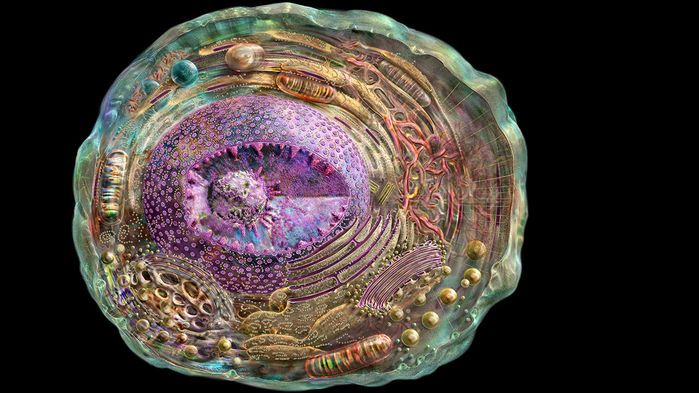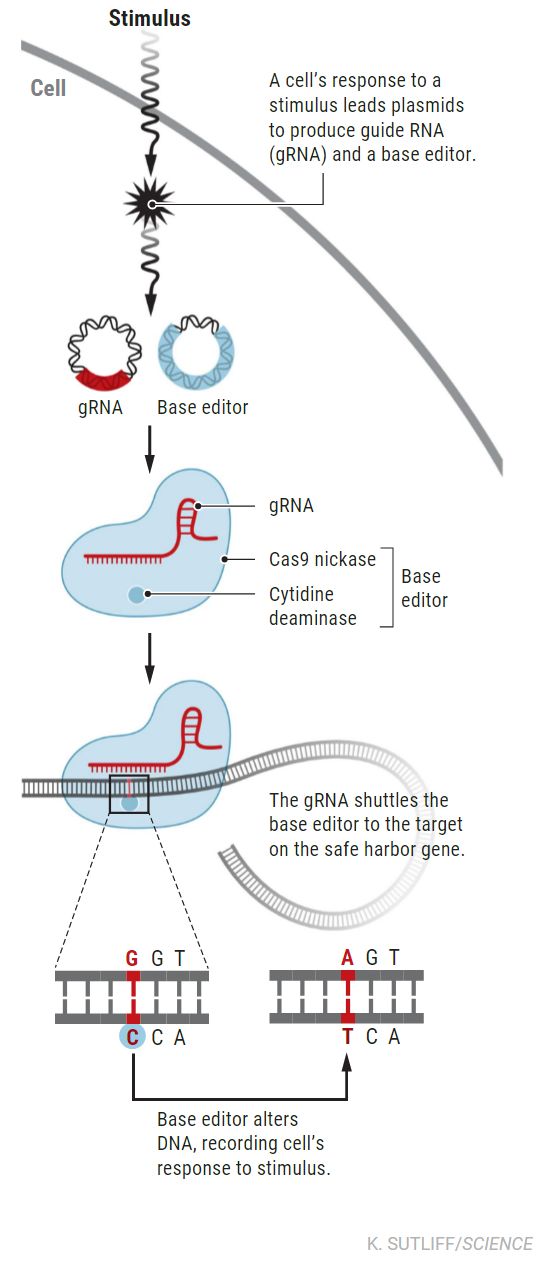Release date: 2018-02-28

Figure: A CRISPR-based recorder can clearly record the source of cellular events Russell Kightley/Science
The aircraft's flight recorder and camera can help investigators understand complex events and find the truth. In the field of scientific research, cell biologists are also trying to establish their own data recording instruments. For example, by linking the gene of interest to the fluorescent protein gene, we can understand the processes such as cancer appearance, aging, environmental influence and embryo development. . The emergence of the revolutionary gene editing tool, CRISPR, provides a better means of recording for new cell recorders, and the new cell recorder can capture DNA data with the help of CRISPR.

David Liu
Recently, Science published a new CRISPR research, and Harvard chemists David Liu and Weixin Tang presented two CRISPR-mediated analog multi-event recorders, the CAMERA system. In the validation experiment, the researchers used the system to successfully record the response of bacteria and human cells to various stimuli such as light, antibiotics, and viral infections, as well as Wnt signal changes.
The researchers proposed two CRISPR-mediated analog multi-event recording devices (CAMERA) systems that use base editors and Cas9 nucleases to record cellular events in bacterial and mammalian cells. The former can specifically recognize DNA sequences, while the latter is responsible for cutting recognition sites. The system uses CAMERA 1 to record signal amplitude or duration to show changes in the ratio of mutually exclusive DNA sequences, while CAMERA 2 displays single base modification changes by recording signal amplitude or duration. In a validation experiment, the order in which the stimulation is administered can be recorded by overlapping guide RNA designs, and the records can be erased and re-entered in multiple cycles. In addition, when recording multiple copies of plasmid information, only 10 to 100 cells are required to obtain reliable data.
Dave Savage, a protein engineer at the University of California at Berkeley, said the innovation in this research is the use of CRISPR to discover cellular molecular pathways, a very creative approach.
It is well known that the initial role of CRISPR is to localize and cleave double-stranded DNA, which is widely used for gene knockout and gene editing. But in the process of CRISPR cleavage, they can introduce random errors into the target gene, making them invalid. Several research teams have used these random errors as markers (or barcodes) to track how cells move from one state to another. The mechanism of "CAMERA" is to use the external signal to stimulate the CRISPR system, record the genetic information changes caused by this effect, and record the genetic changes to understand the stimulation of the cells.
David Liu said that in order to seek a clearer record of information, CAMERA not only records whether a cell has experienced stimulation, but also records the intensity and duration of the stimulus. We hope to see if some cells are performing or ignoring certain signals to stop growing. This helps to better understand the occurrence of cancer.
The first form of CAMERA takes advantage of the fact that the plasmid self-replicates but strictly maintains a certain population number. This form contains two plasmids R1 and R2, the initial ratio of which is stable. The recorder also contains a special plasmid introduced into the gene containing the CRISPR component, which activates the plasmid when it is externally stimulated, and transcribes or translates the guide RNA and Cas9 enzyme in the cell. The R1 plasmid was changed in number. For example, in a test conducted by researchers, when they put an antibiotic-activated CAMERA system in bacteria, by sequencing the bacteria and recording changes in R1:R2, the researchers were able to know how long the cells were exposed to the drug. .

The second form of CAMERA uses a modified Cas9 enzyme that does not cleave double-stranded DNA, but acts on cytosine to convert it to thymine. When the CRISPR system is activated, the guide RNA maps the Cas9 enzyme to the "safe harbor" gene, which can be arbitrarily altered without damaging the cell. Researchers can indirectly record the intensity of signal effects by observing changes in the "safe harbor" gene cytosine. For example, in another test, the researchers turned on CAMERA by activating the Wnt pathway, which plays an important role in embryonic development and cancer development, to record the effects of stimulation signals on the Wnt pathway.
In fact, David Liu was not the first to use Crestron to create a recorder. Prior to this, some scientists had conducted related research, including Timothy Lu of Cambridge Massachusetts Institute of Technology. But Lu pointed out that he designed the system mSCRIBE as an analog recording device that records the duration or amplitude of biological events, but this is limited to bacteria. It requires more than an order of magnitude more cells than CAMERA. Acquire, record reliable signals, and poor signal to noise. And CAMERA is able to work with samples containing only 10 cells, which is of great significance. Because the fewer cells required, the higher the measurement accuracy. He said that David Liu's new study is "very beautiful" and that the level of efficiency and precision is beyond our previous level.
Harvard University geneticist George Church pointed out that if you want to draw a map of brain activity, each cell is different and vital. At the same time, another important significance of CAMERA is that it can record the time and intensity of the signal action. In the case of cancer, this can help us observe the response of cancer cells to different signals at different stages to elucidate its proliferation mechanism. Church said: "The ideal situation is to have a single-molecule automatic recorder that records readable DNA sequences and tells us what is happening to each cell at each time."
In addition, CAMERA has other potential features, such as clearing recorded information, "resetting" the plasmid ratio by drug, and so on. CAMERA can also record the effects of several different signals on cells simultaneously or sequentially. But CAMERA wants to prove its worth, and researchers must prove that it can also work in animals, not just in vitro cell experiments.
references:
Genome editor CRISPR's latest trick? Offering a sharper snapshot of activity inside the cell
Source: Sequencing China
Medical Cold Patch
Patch for diarrhea
[Name] Medical Cold Patch
[Package Dimension] 5cm 4pieces/box
The pain relief patch is composed of three layers, namely, backing lining, middle gel and protective film. It is free from pharmacological, immunological or metabolic ingredients.
[Scope of Application] For cold physiotherapy, closed soft tissue only.
[Indications]
The patches give a fast relief for diarrhea.
[How To Use a Patch]
Please follow the Schematic Diagram. One piece, one time.
The curing effect of each piece can last for 6-8 hours.
[Attention]
Do not apply the patch on the problematic skin, such as wounds, eczema, dermatitis,or in the eyes. People allergic to herbs and the pregnant are advised not to use the medication. If swelling or irritation occurs, please stop using and if any of these effects persist or worsen.notify your doctor or pharmacist promptly. Children using the patch must be supervised by adults.
[Storage Conditions]
Store below 30c in a dry place away from heat and direct sunlight.
Patch For Diarrhea,Medicated Patches For Arthiritis,Plaster For Diarrhea,Pad For Diarrhea
Shandong XiJieYiTong International Trade Co.,Ltd. , https://www.xjytmedical.com